NCERT Solutions For Class 8 Maths Chapter 1 Rational Numbers Introduction
- The counting numbers 1, 2, 3, 4,………… are called natural numbers.
- The smallest natural number is 1. There is no greatest natural number.
- If we add 0 to the collection of natural numbers, what we get is called the collection of whole numbers. are called natural numbers. are whole numbers.
- Every natural number is a whole number but every whole number is not a natural number, e.g., 0 is a whole number but not a natural number.
- The positive integers are the same as natural numbers.
- We get negative integers if we put a negative sign before each positive integer. Thus, – 1, – 2, – 3, – 4,
- The smallest positive integer is 1. The greatest negative integer is -1.
- The number ‘O’ is neither positive nor negative. It is greater than every negative integer and smaller than every positive integer. It is simply an integer.
- Thus, 0, 1, 2, 3, and 4, are negative integers.÷
- Several p/q where p and q are integers and q ≠ 0 is called a rational number.
- All the above types of numbers are needed to solve various kinds of simple algebraic equations
Class 8 Chapter 1 Rational Numbers Worksheet with Answers
Read and Learn More NCERT Solutions For Class 8 Maths
Properties Of Rational Numbers
The list of properties of rational Numbers can be given as follows :
- Closure
- Commutativity
- Associativity
- The role of zero
- The role of 1
- Negative (or additive inverse) of a number
- Reciprocal (or multiplicative inverse)
- Distributivity of multiplication over addition for rational numbers
Closure
Whole numbers
Question 1. 4 + 7 =________________ Is it a whole number
Solution:
4 + 7=11
Yes, It is a whole number.
Question 2. 3 × 7 = _______________Is it a whole number?
Solution:
3 × 7 = 21
Yes, It is a whole number
Question 3. Check for closure property under all four operations for natural numbers
Solution:
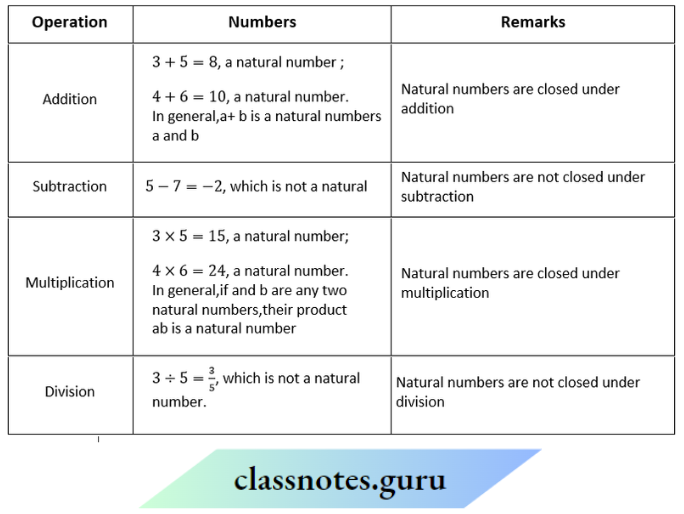
Integers
Question 1. Is – 7 + (- 5) an integer?
Solution:
– 7 + (- 5)
– 7 + (- 5) = – 12
Yes, Which is an integer.
Question 2. Is 8 + 5 an integer?
Solution:
8 + 5
8 + 5 = 13
Yes, Which is an integer
Question 3. Is 5 – 7 an integer?
Solution:
5 – 7
5 – 7 = -2
Yes, Which is an integer.
Question 4. Is 8 – (- 6) an integer?
Solution:
8 – (- 6)
8 – (- 6) = 8 + 6
= 14,
Yes, Which is an integer.
Question 5. Is – 5 × 8= do integer?
Solution:
– 5 × 8
– 5 × 8= – 40
Yes, Which is an integer
Rational numbers
Question 1.\(\frac{-3}{8}+\frac{(-4)}{5}\)= ________ Is it a rational number ?
Solution:
⇒ \(\frac{-3}{8}+\frac{(-4)}{5}\)
=\(\frac{-15+(-32)}{40}\)
= \(\frac{-47}{40}\)
Yes, It is a rational number
Question 2. \(\frac{5}{8}-\frac{4}{5}=\frac{25-32}{40}\) = _________________ it is a ralional number?
Solution:
⇒ \(\frac{5}{8}-\frac{4}{5}\)
= \(\frac{25-32}{40}\)
= \(\frac{-7}{40}\)
Yes, It is a rational number.
Question 3. \(\frac{-5}{9}+\frac{(-7)}{6}\) _______________ Is it a rational number?
Solution:
⇒ \(\frac{3}{7}-\left(\frac{-8}{5}\right)=\frac{3}{7}+\frac{8}{5}\)
= \(\frac{15+56}{35}\)
=\(\frac{71}{35}\) .
Yes, It is a rational number.
Question 4. \(\frac{4}{7}+\frac{6}{11}\) Is it a rational number ?
Solution:
⇒ \(\frac{4}{7}+\frac{6}{11}\)
= \(\frac{44+42}{77}=\frac{86}{77}\)
Yes, It is a rational number
Question 5. \({4}{5} \times \frac{-6}{11}\)___________Is it a rational number?
Solution:
⇒ \(\frac{4}{5} \times \frac{-6}{11}\)
= \(\frac{24}{55}\)
Yes, It is a rational number.
Question 6. \(\frac{2}{7}+\frac{5}{3}\)= _______________Is it a rational number?
Solution:
⇒ \(\frac{2}{7} \div \frac{5}{3}\)
=\(\frac{2}{7} \times \frac{3}{5}\)
= \(\frac{6}{35}\)
Yes, It is a rational number
Question 7. \(\frac{-3}{8}+\frac{-2}{9}\)= ______________ It is a rational numbers
Solution:
⇒ \(\frac{-3}{8} \div \frac{-2}{9}\)
= \(\frac{-3}{8} \times \frac{-9}{2}\)
= \(\frac{27}{16}\)
Yes, it is a rational number.
Rational Numbers Class 8 Maths Notes and Q&A
Question 8. Check it for a few more pairs of rational numbers
1. \(\frac{3}{5}+\frac{7}{13}\)
Solution:
⇒ \(\frac{3}{5}+\frac{7}{13}\)
= \(\frac{39+35}{65}\)
= \(\frac{74}{65}\)
Rational number
2. \(\frac{3}{7}+\frac{(-4)}{9}\)
Solution:
⇒ \(\frac{3}{7}+\frac{(-4)}{9}\)
= \(\frac{27+(-28)}{63}\)
Rational number
3. \(\frac{-5}{9}+\frac{(-7)}{6}\)
Solution:
⇒ \(\frac{-5}{9}+\frac{(-7)}{6}\)
= \(\frac{-10+(-21)}{18}\)
Rational number
Question 9. Try this for some more pairs of rational numbers
1. \(\frac{-3}{8}-\frac{4}{5}\)
Solution:
⇒ \(\frac{-3}{8}-\frac{4}{5}\)
= \(\frac{-15-32}{40}\)
=\(\frac{-47}{40}\)
Rational number
2. \(\frac{2}{9}-\frac{3}{7}\)
Solution:
⇒ \(\frac{2}{9}-\frac{3}{7}\)
= \(\frac{14-27}{63}\)
= –\(\frac{13}{63}\)
Rational number
3. \(\frac{-3}{4} \times \frac{7}{8}\)
Solution:
⇒ \(\frac{-3}{4} \times \frac{7}{8}\)
= –\(\frac{21}{32}\)
Rational number
4. \(\frac{5}{8} \times \frac{3}{7}\)
Solution:
⇒ \(\frac{5}{8} \times \frac{3}{7}\)
= \(\frac{15}{56}\)
Rational number
Question 10. Fill in the blanks in the following table
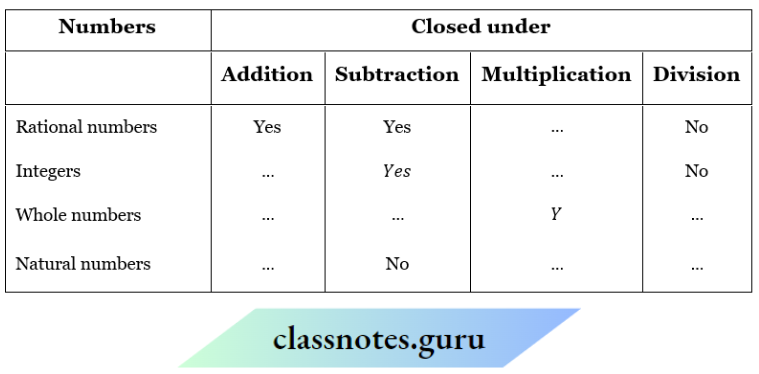
Solution:

Commutativity
Whole numbers
Question 1. Recall the commutativity of different operations for whole numbers by filling the following table.
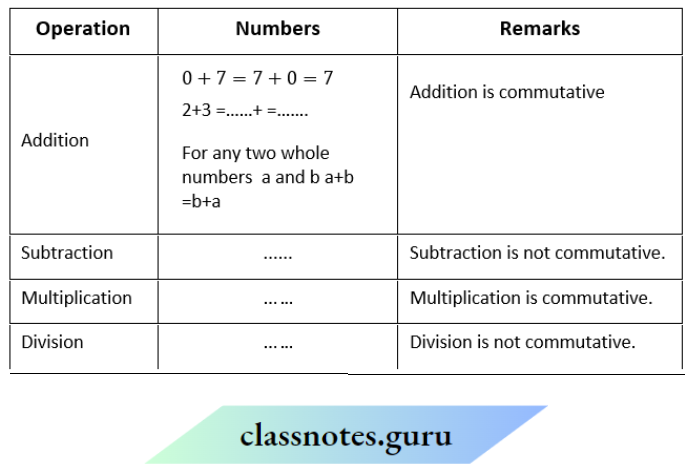
Check whether the commutativity of the. operations hold for natural numbers also.
Solution:
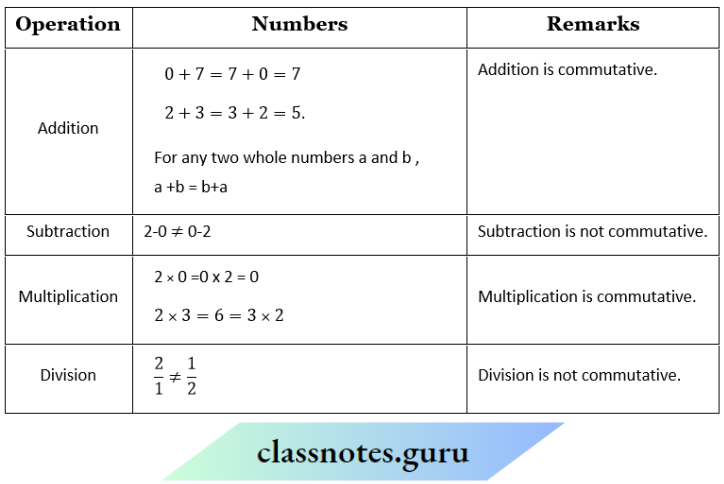
Commutativity of the operations for natural numbers also.
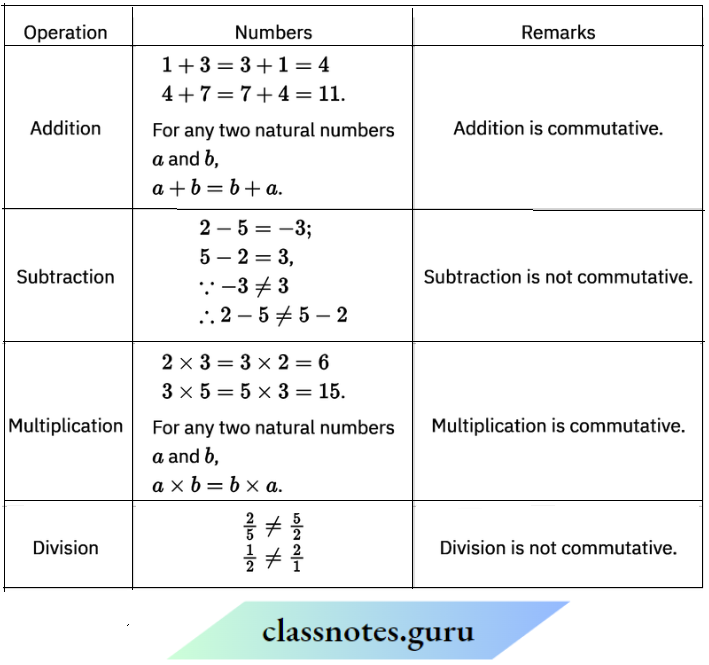
Integers
Question 1. Fill in the following table and check the commutativity of different operations for integers:
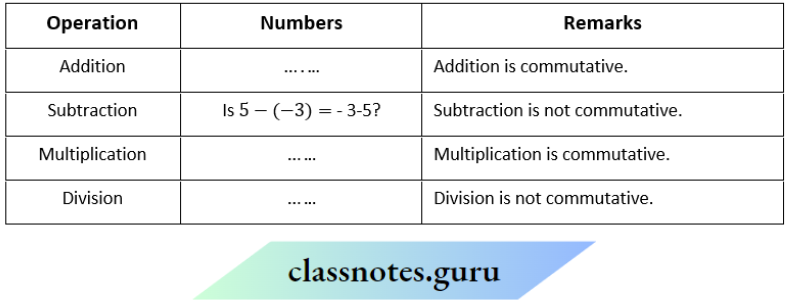
Solution:

Rational numbers
Question 1. \(\frac{-6}{5}+\left(\frac{-8}{3}\right)\) = \(\ldots \ldots \text { and } \frac{-8}{3}+\left(\frac{-6}{5}\right)=\ldots\) Is \(\frac{-6}{5}+\left(\frac{-8}{3}\right) \)= \(\left(\frac{-8}{3}\right)+\left(\frac{-6}{5}\right) \)
Solution:
⇒ \(\frac{-6}{5}+\left(\frac{-8}{3}\right)\)
= \( \frac{-18+(-40)}{15}=\frac{-58}{15}\)
= \(\frac{-8}{3}+\left(\frac{-6}{5}\right)\)
= \(\frac{-40+(-18)}{15}=\frac{-58}{15}\)
So, \(\frac{-6}{5}+\left(\frac{-8}{3}\right)=\left(\frac{-8}{3}\right)+\left(\frac{-6}{5}\right)\)
Question 2. Is \(\frac{3}{8}+\frac{1}{7}=\frac{1}{7}+\left(\frac{-3}{8}\right)\)?
Solution.
⇒ \(\frac{-3}{8}+\frac{1}{7}=\frac{-21+8}{56} \)
= \(\frac{-13}{56}\)
= \(\frac{1}{7}+\left(\frac{-3}{8}\right)=\frac{8+(-21)}{56}\)
= \(\frac{-13}{56}\)
So, \(\frac{-3}{8}+\frac{1}{7}=\frac{1}{7}+\left(\frac{-3}{8}\right)\).
Class 8 Maths Chapter 1 NCERT Workbook Answers
Question 3. Is \(\frac{2}{3}-\frac{5}{4}=\frac{5}{4}-\frac{2}{3}\)
Solution:
⇒ \(\frac{2}{3}-\frac{5}{4}=\frac{8-15}{12}=\frac{-7}{12} \)
⇒ \(\frac{5}{4}-\frac{2}{3}=\frac{15-8}{12}=\frac{7}{12}\)
⇒ \(\frac{-7}{12} \neq \frac{7}{12} \)
∴ \(\frac{2}{3}-\frac{5}{4} \neq \frac{5}{4}-\frac{2}{3} \)
⇒ \(\frac{1}{2}-\frac{3}{5}=\frac{3}{5}-\frac{1}{2} \)
⇒ \(\frac{1}{2}-\frac{3}{5}=\frac{5-6}{10}=\frac{-1}{10} \)
⇒ \(\frac{3}{5}-\frac{1}{2}=\frac{6-5}{10}=\frac{1}{10} \)
⇒ \(\frac{-1}{10} \neq \frac{1}{10} \)
⇒ \(\frac{1}{2}-\frac{3}{5} \neq \frac{3}{5}-\frac{1}{2}\)
Question 4. \(\frac{-8}{9} \times\left(\frac{-4}{7}\right)=\frac{32}{63} \)
Solution:
⇒ \(\frac{-4}{7} \times\left(\frac{-8}{9}\right)=\frac{32}{63}\)
So, \(\frac{-8}{9} \times\left(\frac{-4}{7}\right)=\frac{-4}{7} \times\left(\frac{-8}{9}\right)\)
Question 5. \(\frac{-5}{9} \times \frac{7}{8}\)
Solution:
= \(\frac{7}{8} \times\left(\frac{-5}{9}\right)\)
= \(\frac{-35}{72}\)
Question 6. \(\frac{-6}{11} \times\left(\frac{-3}{5}\right)\)
Solution:
⇒ \(\frac{-6}{11} \times\left(\frac{-3}{5}\right)\)
=\(\frac{-3}{5} \times\left(\frac{-6}{11}\right)\)
= \(\frac{18}{55}\)
⇒ \(\frac{2}{3} \times \frac{4}{7}=\frac{4}{7} \times \frac{2}{3}=\frac{8}{21}\)
Question 7. Is \(\frac{-5}{4} \div \frac{3}{7}=\frac{3}{7}\div\left(\frac{-5}{4}\right)\)
Solution:
⇒ \(\frac{-5}{4} \div \frac{3}{7}=\frac{3}{7} \div\left(\frac{-5}{4}\right)\)
= \(\frac{-35}{12}\)
And \(\frac{3}{7} \div \frac{-5}{4}=\frac{3}{7} \times\left(\frac{-4}{5}\right) \)
= \(\frac{-12}{35}\)
Since \(\frac{-35}{12} \neq \frac{-12}{35} \)
∴ \(\frac{-5}{4} \div \frac{3}{7} \neq \frac{3}{7} \div\left(\frac{-5}{4}\right)\)
Question 8. Complete the following table:

Solution:

Associativity
Whole numbers
Question 1. Recall the associativity of the four operations for whole numbers through this table

Fill in this table and. verify the remarks given in the last column. Check for yourself the associativity of different operations for natural numbers
Solution:
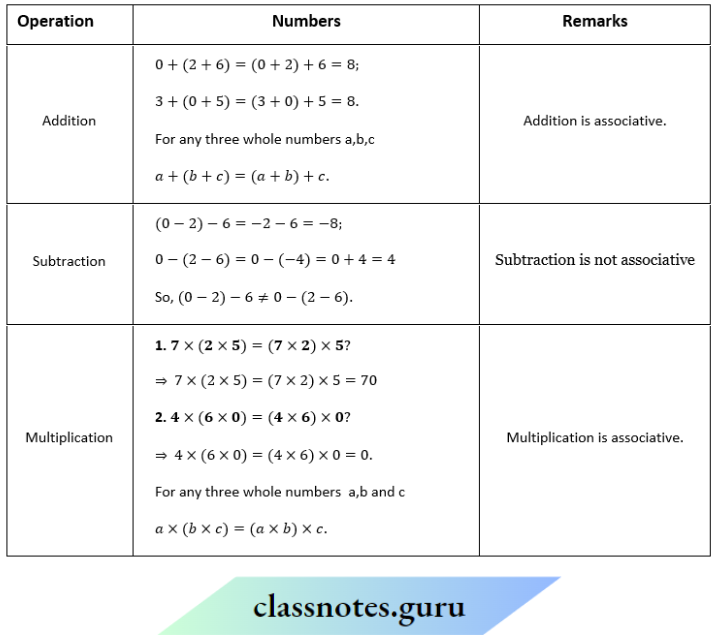
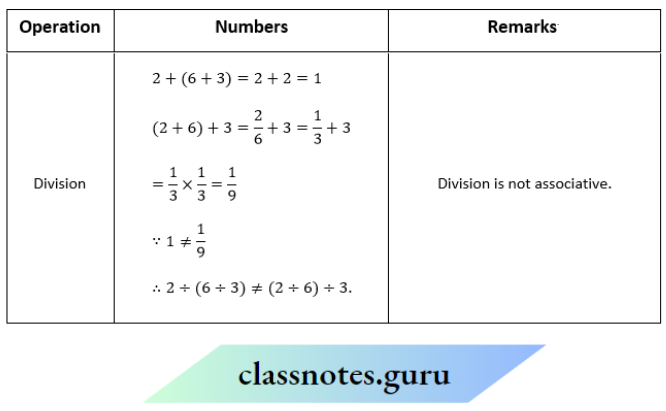
Integers
Question 1. Is (-2) + [3 + (-4)] = [(-2) + 3] + (-4)?
Solution:
Yes; (-2) + [3 + (-4)]
= [(-2) + 3] + (-4)
= -3.
Addition is associative
Question 2. -Is (-6) +[(-4) +(-5)] = (-6) + (-4)] + (-5)?
Solution:
Yes; (-6) + [(-4) + (-5)]
= [(-6) + (-4)] + (-5)
= -15
Addition is associative
NCERT Solutions for Class 8 Maths Chapter 1 Rational Numbers with Explanation
Question 3. Is 5 – (7 – 3) = (5 – 7) – 3?
Solution:
5 – (7 – 3) = 5 – 4
= 1
(5 – 7) – 3 = -2 – 3
= -5
1 ≠ – 5
∴ No; 5 – (7 – 3) ≠ (5 – 7) – 3.
Subtraction is not associative
Question 4. Is 5× [(- 7) × (-8)] = [5× (- 7)] × (- 8) ?
Solution:
Yes; 5 × [(-7) × (-8)]
= [5× (-7)] ×(-8)
= 280.
Multiplication is associative
Question 5. Is (- 4) × [(- 8)×(- 5)]= (-4) x (-8)]× (-5)
Solution:
Yes; (-4) × [(-8) × (-5)]
= [(-4) × (-8)] × (-5)
= -160
Multiplication is associative
Question 6. Is [(-10) ÷ 2] ÷ (- 5)= (-10) ÷[2 ÷ (-5)]?
Solution:
[(-10) ÷ 2] ÷ (-5)= (-5) ÷ (-5) = 1
(-10) ÷ [2 ÷ (-5)]= (-10) ÷ \(\frac{-2}{5}\)
= (-10) ×\(\frac{-5}{2}\)
= 25
∴ 1 ≠ 25
∴ No; [(-10) ÷ 2] ÷ (-5)≠ (-10) ÷ [2 ÷ (-5)]
The division is not associative
Rational numbers
Question 1. Find \(\frac{-1}{2}+\left[\frac{3}{7}+\left(\frac{-4}{3}\right)\right]\) and \(\left[\frac{-1}{2}+\frac{3}{7}\right]+\left(\frac{-4}{3}\right) \text {. }\) Are the two sums equal?
Solution:
⇒ \(\frac{-1}{2}+\left[\frac{3}{7}+\left(\frac{-4}{3}\right)\right]\)
= \(\frac{-1}{2}+\frac{9+(-28)}{21}=\frac{-1}{2}+\left(\frac{-19}{21}\right)\)
= \(\frac{-21+(-38)}{42}=\frac{-59}{42}\)
And \( {\left[\frac{-1}{2}+\frac{3}{7}\right]+\left(\frac{-4}{3}\right)}\)
= \(\frac{-7+6}{14}+\left(\frac{-4}{3}\right)=\frac{-1}{14}+\left(\frac{-4}{3}\right)\)
= \(\frac{-3+(-56)}{42}=\frac{-59}{42}\)
= \(\frac{-1}{2}+\left[\frac{3}{7}+\left(\frac{-4}{3}\right)\right] \)
= \(\left[\frac{-1}{2}+\frac{3}{7}\right]+\left(\frac{-4}{3}\right)\)
= \(\left[\frac{-1}{2}+\frac{3}{7}\right]+\left(\frac{-4}{3}\right)\)
Question 2. \(\frac{-3}{4}+\left[\frac{2}{3}+\left(\frac{-6}{7}\right)\right]\)
Solution:
⇒ \(\frac{-3}{4}+\left[\frac{2}{3}+\left(\frac{-6}{7}\right)\right]\)
= \(\frac{-3}{4}+\frac{14+(-18)}{21}=\frac{-3}{4}+\left(\frac{-4}{21}\right)\)
= \(\frac{-63+(-16)}{84}=\frac{-79}{84} \)
= \(\left[\frac{-3}{4}+\frac{2}{3}\right]+\left(\frac{-6}{7}\right) \)
= \(\frac{-9+(8)}{12}+\left(\frac{-6}{7}\right)=\frac{-1}{12}+\left(\frac{-6}{7}\right) \)
= \(\frac{-7+(-72)}{84}=\frac{-79}{84}\)
So, yes \(\frac{-3}{4}+\left[\frac{2}{3}+\left(\frac{-6}{7}\right)\right]\)
= \(\left[\frac{-3}{4}+\frac{2}{3}\right]+\left(\frac{-6}{7}\right) \)
Question 3. \( \frac{-1}{4}+\left[\frac{2}{9}\right.\left.+\left(\frac{-5}{11}\right)\right] \)
Solution:
⇒ \( \frac{-1}{4}+\left[\frac{2}{9}\right.\left.+\left(\frac{-5}{11}\right)\right] \)
= \(\frac{-1}{4}+\left(\frac{22-(45)}{99}\right) \)
= \(\frac{-1}{4}+\left(\frac{-23}{99}\right) \)
⇒ \(\left[\frac{-1}{4}\right.\left.+\frac{2}{9}\right]+\left(\frac{-5}{11}\right)\)
= \(\frac{-99+(-92)}{396}=\frac{-191}{396}\)
= \(\frac{-9+8}{36}+\left(\frac{-5}{11}\right)\)
= \(\frac{-1}{36}+\left(\frac{-5}{11}\right)=\frac{-11+(-180)}{396}\)
= \(\frac{-191}{396} \)
⇒ \(\frac{-1}{4}+\left[\frac{2}{9}+\left(\frac{-5}{11}\right)\right] \)
= \(\left[\frac{-1}{4}+\frac{2}{9}\right]+\left(\frac{-5}{11}\right)\)
Question 4. \(\frac{-2}{3}-\left[\frac{-4}{5}-\frac{1}{2}\right]\) Check for yourself
Solution:
= \(\left[\frac{-2}{3}-\left(\frac{-4}{5}\right)\right]-\frac{1}{2}\)
= \(\frac{-2}{3}-\left[\frac{-4}{5}-\frac{1}{2}\right]\)
= \(\frac{-2}{3}-\left(\frac{-8-5}{10}\right)=\frac{-2}{3}-\left(\frac{-13}{10}\right)\)
= \(\frac{-2}{3}+\frac{13}{10}=\frac{-20+39}{30}=\frac{19}{30}\)
And \({\left[\frac{-2}{3}-\left(\frac{-4}{5}\right)\right]-\frac{1}{2}=\left[\frac{-2}{3}+\frac{4}{5}\right]-\frac{1}{2}} \)
= \(\left[\frac{-10+12}{15}\right]-\frac{1}{2}=\frac{2}{15}-\frac{1}{2} \)
= \(\frac{4-15}{30}=\frac{-11}{30}\)
So, No ; \(\frac{-2}{3}-\left[\frac{-4}{5}-\frac{1}{2}\right]\)≠ \(\frac{-2}{3}\)– (\(\frac{-4}{5}\)) – \(\frac{1}{2}\)
Question 5. \(\left(\frac{-7}{3} \times \frac{5}{4}\right) \times \frac{2}{9}\)___________
Solution:
⇒\(\left(\frac{-7}{3} \times \frac{5}{4}\right) \times \frac{2}{9}=\frac{-35}{12} \times \frac{2}{9}\)
=\(\frac{-35}{54}\)
So, Yes ;
Question 6. Is \(\frac{2}{3} \times\left(\frac{-6}{7} \times \frac{4}{5}\right)=\left(\frac{2}{3} \times \frac{-6}{7}\right) \times \frac{4}{5} \)
Solution:
⇒ \(\frac{2}{3} \times\left(\frac{-6}{7} \times \frac{4}{5}\right)\)
= \(\frac{2}{3} \times \frac{-24}{35}=\frac{-48}{105}\)________ (1)
= \(\frac{2}{3}\)× \(\frac{-6}{7}\)× \(\frac{4}{5}\)
= \(\frac{-12}{21} \times \frac{4}{5}=\frac{-48}{105}\)________ (2)
So, Yes; A = B
Class 8 Maths Chapter 1 Rational Numbers Step-by-Step Answers
Question 7. \(\frac{-6}{5} \times\left(\frac{2}{3} \times \frac{1}{8}\right)\)
Solution:
⇒ \(\frac{-6}{5} \times\left(\frac{2}{3} \times \frac{1}{8}\right)=\frac{-6}{5} \times \frac{1}{12}\)
=\(\frac{-1}{10}\)
And \(\left(\frac{-6}{5} \times \frac{2}{3}\right) \times \frac{1}{8}=\frac{-4}{5} \times \frac{1}{8}=\frac{-1}{10}\)
So, Yes
⇒ \(\frac{-6}{5} \times\left(\frac{2}{3} \times \frac{1}{8}\right)=\left(\frac{-6}{5} \times \frac{2}{3}\right) \times \frac{1}{8}\)
Question 8. \(\frac{2}{7} \times\left(\frac{-5}{9} \times \frac{2}{3}\right) \)
Solution:
⇒ \(\frac{2}{7} \times\left(\frac{-5}{9} \times \frac{2}{3}\right) \)
=\(\frac{2}{7} \times\left(\frac{-10}{27}\right)=\frac{-20}{189} \)
= \(\left(\frac{2}{7} \times \frac{-5}{9}\right) \times \frac{2}{3}=\frac{-10}{63} \times \frac{2}{3}\)
=\(\frac{-20}{189}\)
So, Yes; A=B
Question 9. \(\frac{1}{2}+\left[\frac{-1}{3}+\frac{2}{5}\right]=\left[\frac{1}{2}+\left(\frac{-1}{3}\right)\right]+\frac{2}{5}\),Is L.H.S. =R.H.S. ? Check for yourself
Solution:
L.H.S.\(\frac{1}{2}+\left(\frac{-1}{3}+\frac{2}{5}\right)\)
= \(\frac{1}{2} \div\left(\frac{-1}{3} \times \frac{5}{2}\right)\)
= \(\frac{2}{5} is \frac{5}{2}\)
= \(\frac{1}{2}+\left(-\frac{5}{6}\right) \)
= \(\frac{1}{2} \times \frac{-6}{5}=\frac{-3}{5} \)
R.H.S= \(\left[\frac{1}{2}+\left(\frac{-1}{3}\right)\right]+\frac{2}{5}\)
= \(\left(\frac{1}{2} \times \frac{-3}{1}\right) \div \frac{2}{5}=\frac{-3}{2}+\frac{2}{5} \)
= \(\frac{-3}{2} \times \frac{5}{2}=\frac{-15}{4}\)
So, No; L.H.S ≠R. H.S.
Question 10. Complete the following table:
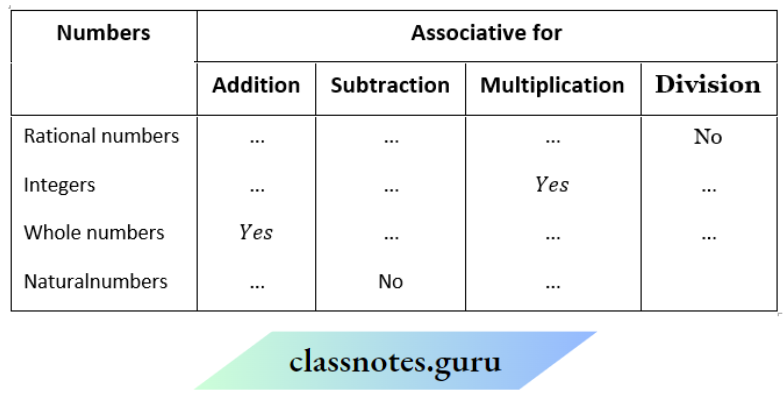
Solution:
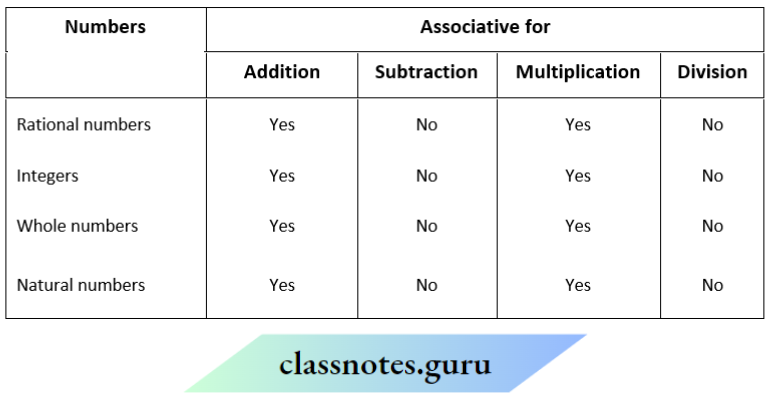
Question 11. Do you think the properties commutativity and associativity made the calculations
Solution.
Yes! The properties of commutativity and associativity made the calculations easier
The Rolie Of Zero (0)
Question 1. \(-5+0=\ldots \ldots. \ldots \ldots .=-5\)
Solution:
-5+0=0+(-5)=-5
Question 2. \(\frac{-2}{7}+\ldots \ldots .=0+\left(\frac{-2}{7}\right)=\frac{-2}{7}\)
⇒ \(\frac{-2}{7}+0=0+\left(\frac{-2}{7}\right)=\frac{-2}{7}\)
Question 3. Do a few more such additions. What do you observe?
Solution:
1. 3 + 0 = 0 + 3 = 3
2. -9 +0 = 0 + (-9) = -9
3.\(\frac{-3}{4}+0=0+\left(\frac{-3}{4}\right)=\frac{-3}{4}\)
We observe that when we add 0 to a whole number, the sum is again that whole number. This happens for integers and rational numbers also.
The Role Of 1
Question 1. \(\frac{-2}{7} \times 1=\ldots \ldots . . \times \ldots . .=\frac{-2}{7}\)
Solution:
– \(\frac{2}{7} \times 1=1 \times \frac{-2}{7}=\frac{-2}{7}\)
Question 2. \(\frac{3}{8} \times \ldots \ldots=1 \times \frac{3}{8}=\frac{3}{8}\)
Solution:
⇒ \(\frac{3}{8} \times 1=1 \times \frac{3}{8}\)
= \(\frac{3}{8}\)
Question 3. What do you find?
Solution:
We find that when we multiply any rational number by 1, we get back the same rational number as the product
Question 4. Check for a few more rational numbers
1. 7 × 1
Solution:
7 × 1 = 7 = 1 × 7
2.\(\frac{-3}{5} \times 1\)
Solution:
⇒ \(\frac{-3}{5} \times 1\)
=\(1 \times \frac{-3}{5}=\frac{-3}{5}\)
3. \(\frac{7}{9} \times 1\)
Solution:
⇒ \(\frac{7}{9} \times 1\)
= \(1 \times \frac{7}{9}=\frac{7}{9}\)
Question 5. Is 1 the multiplicative identity for integers? For whole numbers?
Solution:
Yes, 1 is the multiplicative identity for integers as well as for whole numbers.
Question 6. If a property holds for rational numbers, will it also hold for integers?
- For whole numbers?
- Which will?
- Which will not?
Solution:
1. Except for the following property, the properties of the rational numbers will also hold good for integers :
If a and b are rational numbers, then a÷b is also a rational number if b ≠ 0 but a÷ b is not necessarily an integer where a and b are integers
Example: \(\frac{4}{5}\)is a rational number. Here 4 and 5 are integers, while \(\frac{4}{5}\) is not an integer
2. Except for the following properties, the properties of the rational numbers will also hold good for whole numbers:
If a and b are rational numbers, then, a- b is also a rational number. But if a and b are whole numbers, then A b is not necessarily a whole number
Let 4 and 5 be whole numbers, but 4 – 5 = -1 is not a whole number.
2. If a and b are rational numbers, then, a + b is a rational number if b but if a and b are whole numbers, then a + b is not necessarily a whole number.
Example: 4 and 5 are whole numbers but \(\frac{4}{5}\) is not a whole number
Rational Numbers Class 8 NCERT Solutions with Practice Questions
Disberstivity Of Multiplication Over Addition For Rational
For all rational numbers a, b, and c,
a(b + c) = ab + ac.
a(b-c) = ab – ac
Question 1. \(\left\{\frac{7}{5} \times\left(\frac{-3}{12}\right)\right\}+\left\{\frac{7}{5} \times \frac{5}{12}\right\}\)
Solution:
⇒ \(\left\{\frac{7}{\mathbf{5}} \times\left(\frac{-3}{12}\right)\right\}+\left\{\frac{7}{5} \times \frac{\mathbf{5}}{\mathbf{1 2}}\right\}\)
= \(\frac{7}{5} \times\left\{\left(\frac{-3}{12}\right)+\frac{5}{12}\right\} \)
= \(\frac{7}{5} \times\left\{\frac{(-3)+5}{12}\right\}=\frac{7}{5} \times \frac{2}{12} \)
= \(\frac{7}{5} \times \frac{1}{6}=\frac{7}{30} \)
Question 2. \(\left\{\frac{9}{16} \times \frac{4}{12}\right\}+\left\{\frac{9}{16} \times \frac{-3}{9}\right\}\)
Solution:
⇒ \(\left\{\frac{9}{16} \times \frac{4}{12}\right\}+\left\{\frac{9}{16} \times \frac{-3}{9}\right\} \)
= \(\frac{9}{16} \times\left\{\frac{4}{12}+\left(\frac{-3}{9}\right)\right\}\)
= \(\frac{9}{16} \times\left\{\frac{1}{3}+\left(\frac{-1}{3}\right)\right\} \)
= \(\frac{9}{16} \times\left\{\frac{1-1}{3}\right\}=\frac{9}{16} \times 0=0 .\)
NCERT Solutions For Class 8 Maths Chapter 1 Rational Numbers Exercise 1.1
Question 1. Name the property under multiplication used in each of the following
1. \( \frac{-4}{5} \times 1=1 \times \frac{-4}{5}=-\frac{4}{5} \)
2. \(\frac{13}{17} \times \frac{-2}{7}=\frac{-2}{7} \times \frac{-13}{17}\)
3. \(\frac{-19}{29} \times \frac{29}{-19}=1\)
Solution:
1.1 is the multiplicative identity
2. Commutativity of multiplication
3. Multiplicative inverse.
Question 2. Tell what property allows you tocompute :\(\frac{1}{3} \times\left(6 \times \frac{4}{3}\right) \text { as }\left(\frac{1}{3} \times 6\right) \times \frac{4}{3} \text {. }\)
Solution:
Associativity of multiplication
Question 3. The product of two rational numbers is always a
Solution:
The product of two rational numbers is always a rational number.
NCERT Solutions For Class 8 Maths Chapter 1 Rational Numbers Multiple Choice Questions
Question 1. Which of the following statements is false?
- Natural numbers are closed under addition
- Whole numbers are closed under the addition
- Integers are closed under the addition
- Rational numbers are not closed under addition.
Solution: 4. Rational numbers are not closed under addition.
Question 2. Which of the following statements is false?
- Natural numbers are closed under subtraction
- Whole numbers are not closed under subtraction
- Integers are closed under subtraction
- Rational numbers are closed under subtraction.
Solution: 1. Natural numbers are closed under subtraction
Question 3. Which of the following statements is true?
- Natural numbers are closed under multiplication
- Whole numbers are not closed under multiplication
- Integers are not closed under multiplication
- Rational numbers are not closed under multiplication.
Solution: 1. Natural numbers are closed under multiplication
Question 4. Which of the following statements is true?
- Natural numbers are closed under the division
- Whole numbers are not closed under the division
- Integers are closed under the division
- Rational numbers are closed under division.
Solution: 2. Whole numbers are not closed under the division
Question 5. Which of the following statements is false?
- Natural numbers are commutative for addition
- Whole numbers are commutative for addition
- Integers are not commutative for addition
- Rational numbers are commutative for addition.
Solution: 3. Integers are not commutative for addition
Question 6. Which of the following statements is true?
- Natural numbers are commutative for subtraction
- Whole numbers are commutative for subtraction
- Integers are commutative for subtraction
- Rational numbers are not commutative for subtraction.
Solution: 4. Rational numbers are not commutative for subtraction.
Question 7. Which of the following statements is false?
- Natural numbers are commutative for multiplication
- Whole numbers are commutative for multiplication
- Integers are not commutative for multiplication
- Rational numbers are commutative for multiplication.
Solution: 3. Integers are not commutative for multiplication
Question 8. Which of the following statements is true?
- Natural numbers are commutative for division
- Whole numbers are not commutative for division
- Integers are commutative for division
- Rational numbers are commutative for division.
Solution: 2. Whole numbers are not commutative for division
Question 9. Which of the following statements is true?
- Natural numbers are associative for addition
- Whole numbers are not associative for addition
- Integers are not associative for addition
- Rational numbers are not associative for addition.
Solution: 1. Natural numbers are associative for addition
Question 10. Which of the following statements is true?
- Natural numbers are associative for subtraction
- Whole numbers are not associative for subtraction
- Integers are associative for subtraction
- Rational numbers are associative for subtraction
Solution: 2. Whole numbers are not associative for subtraction
Question 11. Which of the following statements is true?
- Natural numbers are not associative for multiplication
- Whole numbers are not associative for multiplication
- Integers are associative for multiplication
- Rational numbers are not associative for multiplication.
Solution: 3. Integers are associative for multiplication
Rational Numbers Class 8 NCERT Solutions with Practice Questions
Question 12. Which of the following statements is true?
- Natural numbers are associative for division
- Whole numbers are associative for division
- Integers are associative for division
- Rational numbers are not associative for division
Solution: 4. Rational numbers are not associative for division
Question 13. 0 is not
- A natural number
- A whole number
- An integer
- A rational number.
Solution: 1. A natural number
Question 14. ½ is
- A natural number
- A whole number
- A n integer
- A rational number.
Solution: 4. A rational number.
Question 15. a + 6 = 6 + a is called
- Commutative law of addition
- Associative law of addition
- Distributive law of addition
- None of these.
Solution: 1. Commutative law of addition
Question 16. a × b = b × a is called
- Commutative law for addition
- Commutative law for multiplication
- Associative law for addition
- Associative law for multiplication.
Solution: 2. Commutative law for multiplication
Question 17. (a + b) + c = a + (b + c) is called
- Commutative law for multiplication
- Commutative law for
- Addition associative law for addition
- Associative law for multiplication.
Solution: 3. Addition associative law for addition
Question 18. a × (b × c) = (a × b) × c is called
- Associative law for addition
- Associative law for multiplication
- Commutative law for addition
- Commutative law for multiplication.
Solution: 2. Associative law for multiplication
Question 19. a (6 + c) = ab + ac is called
- Commutative law
- Associative law
- Distributive law
- None of these
Solution: 3. Distributive law
Question 20. The additive identity for rational numbers is
- 1
- -1
- 0
- None of these.
Solution: 3. 0
Question 21. The multiplicative identity for rational numbers is
- -1
- 1
- 0
- None of these
Solution: 2. 1
Question 22. How many rational numbers are there between any two given rational numbers?
- Only one
- Only two
- Countless
- Nothing can be said.
Solution: 3. Countless
Question 23. If a and 6 are two continuous rational numbers, then
- \(\frac{a+b}{2}<a\)
- \(\frac{a+b}{2}<b\)
- \(\frac{a+b}{2}=a\)
- \(\frac{a+b}{2}>b\)
Solution: 2. \(\frac{a+b}{2}<b\)
NCERT Solutions For Class 8 Maths Chapter 1 Rational Numbers True Or False
1. a – 0 and 0 – a represent the same rational number where a ≠ 0. – False
2. 0 is a rational number – True
3. Between any two given rational numbers, there are countless rational numbers – True
NCERT Solutions For Class 8 Maths Chapter 1 Rational Numbers Fill In The Blanks
1. A number of the form p/q, where p and q are integers and q ≠0 is called a → Rational number
2. Write the number 0 reduced by 1 → (-1)
3. Are the two rational numbers p/q and q≠0 equivalent →Yes
4. In the rational number p/q, why q≠0 → Since division by zero is not defined
5. Which rational number on the number line is equidistant from 0 and -1 → (\(\frac{-1}{2}\)).
